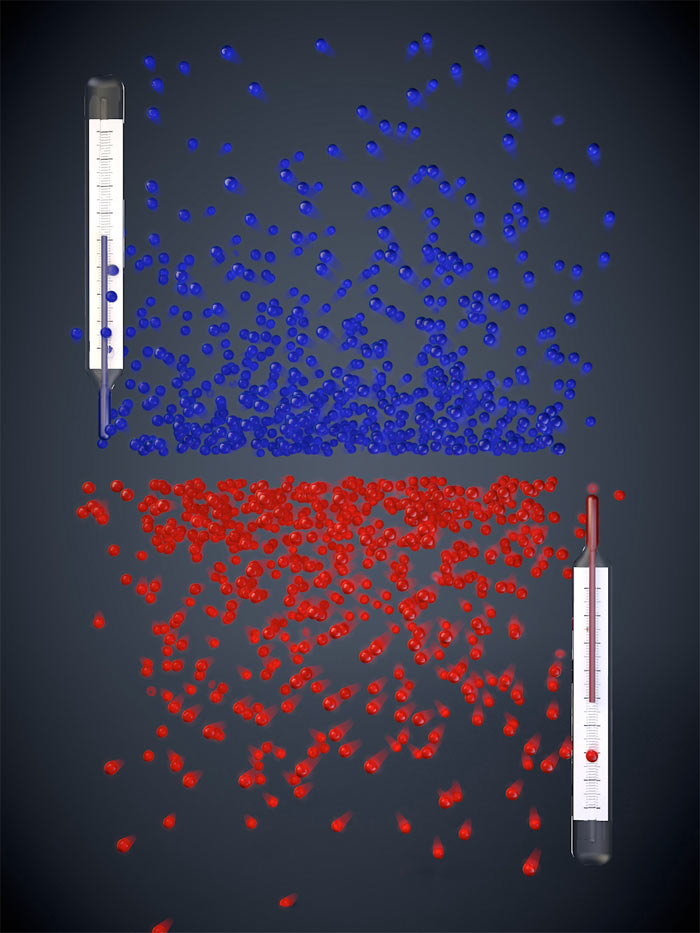Atoms Reach Record Temperature, Colder than Absolute Zero

Absolute zero is often thought to be the coldest temperature possible. But now researchers show they can achieve even lower temperatures for a strange realm of "negative temperatures."
Oddly, another way to look at these negative temperatures is to consider them hotter than infinity, researchers added.
This unusual advance could lead to new engines that could technically be more than 100 percent efficient, and shed light on mysteries such as dark energy, the mysterious substance that is apparently pulling our universe apart.
An object's temperature is a measure of how much its atoms move — the colder an object is, the slower the atoms are. At the physically impossible-to-reach temperature of zero kelvin, or minus 459.67 degrees Fahrenheit (minus 273.15 degrees Celsius), atoms would stop moving. As such, nothing can be colder than absolute zero on the Kelvin scale.
Bizarro negative temperatures
To comprehend the negative temperatures scientists have now devised, one might think of temperature as existing on a scale that is actually a loop, not linear. Positive temperatures make up one part of the loop, while negative temperatures make up the other part. When temperatures go either below zero or above infinity on the positive region of this scale, they end up in negative territory. [What's That? Your Basic Physics Questions Answered]
With positive temperatures, atoms more likely occupy low-energy states than high-energy states, a pattern known as Boltzmann distribution in physics. When an object is heated, its atoms can reach higher energy levels.
Get the world’s most fascinating discoveries delivered straight to your inbox.
At absolute zero, atoms would occupy the lowest energy state. At an infinite temperature, atoms would occupy all energy states. Negative temperatures then are the opposite of positive temperatures — atoms more likely occupy high-energy states than low-energy states.
"The inverted Boltzmann distribution is the hallmark of negative absolute temperature, and this is what we have achieved," said researcher Ulrich Schneider, a physicist at the University of Munich in Germany. "Yet the gas is not colder than zero kelvin, but hotter. It is even hotter than at any positive temperature — the temperature scale simply does not end at infinity, but jumps to negative values instead."
As one might expect, objects with negative temperatures behave in very odd ways. For instance, energy typically flows from objects with a higher positive temperature to ones with a lower positive temperature — that is, hotter objects heat up cooler objects, and colder objects cool down hotter ones, until they reach a common temperature. However, energy will always flow from objects with negative temperature to ones with positive temperatures. In this sense, objects with negative temperatures are always hotter than ones with positive temperatures.
Another odd consequence of negative temperatures has to do with entropy, which is a measure of how disorderly a system is. When objects with positive temperature release energy, they increase the entropy of things around them, making them behave more chaotically. However, when objects with negative temperatures release energy, they can actually absorb entropy.
Negative temperatures would be thought impossible, since there is typically no upper bound for how much energy atoms can have, as far as theory currently suggests. (There is a limit to what speed they can travel — according to Einstein's theory of relativity, nothing can accelerate to speeds faster than light.)
Wacky physics experiment
To generate negative temperatures, scientists created a system where atoms do have a limit to how much energy they can possess. They first cooled about 100,000 atoms to a positive temperature of a few nanokelvin, or billionth of a kelvin. They cooled the atoms within a vacuum chamber, which isolated them from any environmental influence that could potentially heat them up accidentally. They also used a web of laser beams and magnetic fields to very precisely control how these atoms behaved, helping to push them into a new temperature realm. [Twisted Physics: 7 Mind-Blowing Findings]
"The temperatures we achieved are negative nanokelvin," Schneider told LiveScience.
Temperature depends on how much atoms move — how much kinetic energy they have. The web of laser beams created a perfectly ordered array of millions of bright spots of light, and in this "optical lattice," atoms could still move, but their kinetic energy was limited.
Temperature also depends on how much potential energy atoms have, and how much energy lies in the interactions between the atoms. The researchers used the optical lattice to limit how much potential energy the atoms had, and they used magnetic fields to very finely control the interactions between atoms, making them either attractive or repulsive.
Temperature is linked with pressure — the hotter something is, the more it expands outward, and the colder something is, the more it contracts inward. To make sure this gas had a negative temperature, the researchers had to give it a negative pressure as well, tinkering with the interactions between atoms until they attracted each other more than they repelled each other.
"We have created the first negative absolute temperature state for moving particles," said researcher Simon Braun at the University of Munich in Germany.
New kinds of engines
Negative temperatures could be used to create heat engines — engines that convert heat energy to mechanical work, such as combustion engines — that are more than 100-percent efficient, something seemingly impossible. Such engines would essentially not only absorb energy from hotter substances, but also colder ones. As such, the work the engine performed could be larger than the energy taken from the hotter substance alone.
Negative temperatures might also help shed light on one of the greatest mysteries in science. Scientists had expected the gravitational pull of matter to slow down the universe's expansion after the Big Bang, eventually bringing it to a dead stop or even reversing it for a "Big Crunch." However, the universe's expansion is apparently speeding up, accelerated growth that cosmologists suggest may be due to dark energy, an as-yet-unknown substance that could make up more than 70 percent of the cosmos.
In much the same way, the negative pressure of the cold gas the researchers created should make it collapse. However, its negative temperature keeps it from doing so. As such, negative temperatures might have interesting parallels with dark energy that may help scientists understand this enigma.
Negative temperatures could also shed light on exotic states of matter, generating systems that normally might not be stable without them. "A better understanding of temperature could lead to new things we haven't even thought of yet," Schneider said. "When you study the basics very thoroughly, you never know where it may end."
The scientists detailed their findings in the Jan. 4 issue of the journal Science.
Follow LiveScience on Twitter @livescience. We're also on Facebook & Google+.



